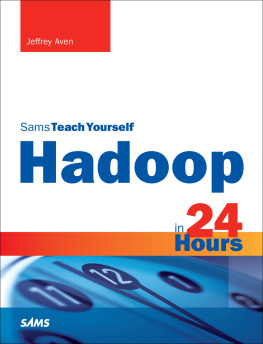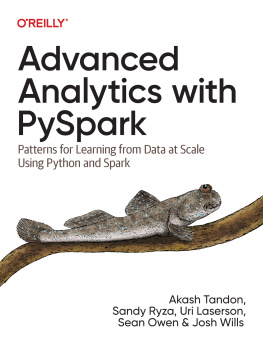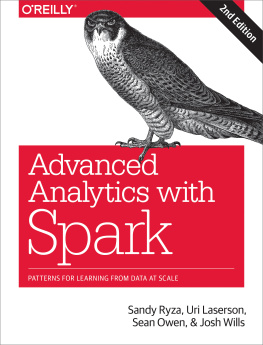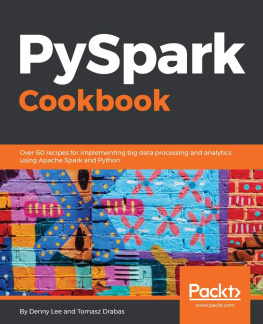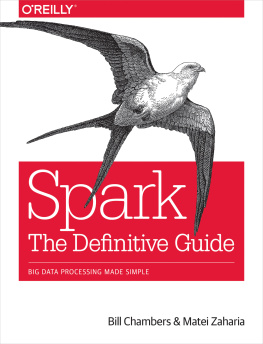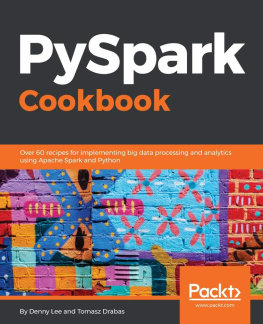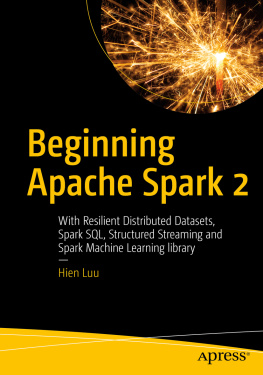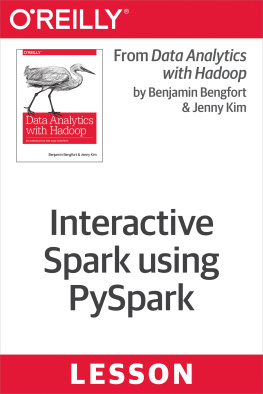About This E-Book
EPUB is an open, industry-standard format for e-books. However, support for EPUB and its many features varies across reading devices and applications. Use your device or app settings to customize the presentation to your liking. Settings that you can customize often include font, font size, single or double column, landscape or portrait mode, and figures that you can click or tap to enlarge. For additional information about the settings and features on your reading device or app, visit the device manufacturers Web site.
Many titles include programming code or configuration examples. To optimize the presentation of these elements, view the e-book in single-column, landscape mode and adjust the font size to the smallest setting. In addition to presenting code and configurations in the reflowable text format, we have included images of the code that mimic the presentation found in the print book; therefore, where the reflowable format may compromise the presentation of the code listing, you will see a Click here to view code image link. Click the link to view the print-fidelity code image. To return to the previous page viewed, click the Back button on your device or app.
Data Analytics with Spark Using Python
Jeffrey Aven

Boston Columbus Indianapolis New York San Francisco Amsterdam Cape Town Dubai London Madrid Milan Munich Paris Montreal Toronto Delhi Mexico City So Paulo Sydney Hong Kong Seoul Singapore Taipei Tokyo
Many of the designations used by manufacturers and sellers to distinguish their products are claimed as trademarks. Where those designations appear in this book, and the publisher was aware of a trademark claim, the designations have been printed with initial capital letters or in all capitals.
The author and publisher have taken care in the preparation of this book, but make no expressed or implied warranty of any kind and assume no responsibility for errors or omissions. No liability is assumed for incidental or consequential damages in connection with or arising out of the use of the information or programs contained herein.
For information about buying this title in bulk quantities, or for special sales opportunities (which may include electronic versions; custom cover designs; and content particular to your business, training goals, marketing focus, or branding interests), please contact our corporate sales department at or (800) 382-3419.
For government sales inquiries, please contact .
For questions about sales outside the U.S., please contact .
Visit us on the Web: informit.com/aw
Library of Congress Control Number: 2018938456
2018 Pearson Education, Inc.
All rights reserved. This publication is protected by copyright, and permission must be obtained from the publisher prior to any prohibited reproduction, storage in a retrieval system, or transmission in any form or by any means, electronic, mechanical, photocopying, recording, or likewise. For information regarding permissions, request forms, and the appropriate contacts within the Pearson Education Global Rights & Permissions Department, please visit www.pearsoned.com/permissions/.
Microsoft and/or its respective suppliers make no representations about the suitability of the information contained in the documents and related graphics published as part of the services for any purpose. All such documents and related graphics are provided as is without warranty of any kind. Microsoft and/ or its respective suppliers hereby disclaim all warranties and conditions with regard to this information, including all warranties and conditions of merchantability, whether express, implied or statutory, fitness for a particular purpose, title and non-infringement. In no event shall Microsoft and/or its respective suppliers be liable for any special, indirect or consequential damages or any damages whatsoever resulting from loss of use, data or profits, whether in an action of contract, negligence or other tortious action, arising out of or in connection with the use or performance of information available from the services. The documents and related graphics contained herein could include technical inaccuracies or typographical errors. Changes are periodically added to the information herein. Microsoft and/or its respective suppliers may make improvements and/or changes in the product(s) and/or the program(s) described herein at any time. Partial screenshots may be viewed in full within the software version specified.
Microsoft Windows, and Microsoft Office are registered trademarks of the Microsoft Corporation in the U.S.A. and other countries. This book is not sponsored or endorsed by or affiliated with the Microsoft Corporation.
ISBN-13: 978-0-13-484601-9
ISBN-10: 0-13-484601-X
1 18
Editor-in-Chief
Greg Wiegand
Executive Editor
Trina MacDonald
Development Editor
Amanda Kaufmann
Managing Editor
Sandra Schroeder
Senior Project Editor
Lori Lyons
Technical Editor
Yaniv Rodenski
Copy Editor
Catherine D. Wilson
Project Manager
Dhayanidhi Karunanidhi
Indexer
Erika Millen
Proofreader
Jeanine Furino
Cover Designer
Chuti Prasertsith
Compositor
codemantra
Contents at a Glance
Table of Contents
Preface
Spark is at the heart of the disruptive Big Data and open source software revolution. The interest in and use of Spark have grown exponentially, with no signs of abating. This book will prepare you, step by step, for a prosperous career in the Big Data analytics field.
Focus of the Book
This book focuses on the fundamentals of the Spark project, starting from the core and working outward into Sparks various extensions, related or subprojects, and the broader ecosystem of open source technologies such as Hadoop, Kafka, Cassandra, and more.
Although the foundational understanding of Spark concepts covered in this bookincluding the runtime, cluster and application architectureare language independent and agnostic, the majority of the programming examples and exercises in this book are written in Python. The Python API for Spark (PySpark) provides an intuitive programming environment for data analysts, data engineers, and data scientists alike, offering developers the flexibility and extensibility of Python with the distributed processing power and scalability of Spark.
The scope of this book is quite broad, covering aspects of Spark from core Spark programming to Spark SQL, Spark Streaming, machine learning, and more. This book provides a good introduction and overview for each topicenough of a platform for you to build upon any particular area or discipline within the Spark project.
Who Should Read This Book
This book is intended for data analysts and engineers looking to enter the Big Data space or consolidate their knowledge in this area. The demand for engineers with skills in Big Data and its preeminent processing framework, Spark, is exceptionally high at present. This book aims to prepare readers for this growing employment market and arm them with the skills employers are looking for.
Python experience is useful but not strictly necessary for readers of this book as Python is quite intuitive for anyone with any programming experience whatsoever. A good working knowledge of data analysis and manipulation would also be helpful. This book is especially well suited to data warehouse professionals interested in expanding their careers into the Big Data area.


